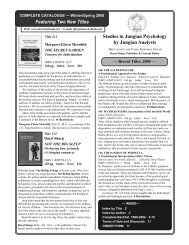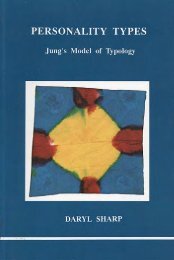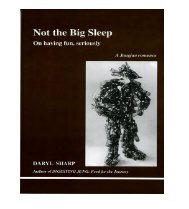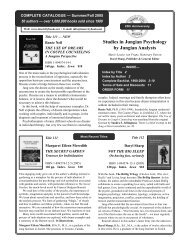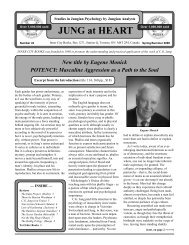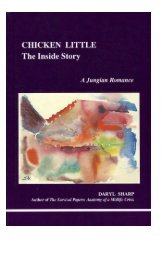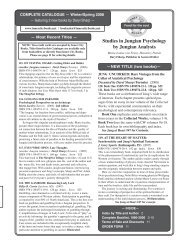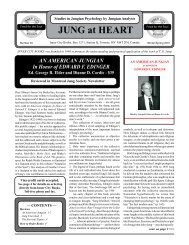Digesting Jung: Food for the Journey - Inner City Books
Digesting Jung: Food for the Journey - Inner City Books
Digesting Jung: Food for the Journey - Inner City Books
You also want an ePaper? Increase the reach of your titles
YUMPU automatically turns print PDFs into web optimized ePapers that Google loves.
42 Man’s <strong>Inner</strong> Woman<br />
<strong>the</strong>m—a man can come into possession of his soul ra<strong>the</strong>r than be<br />
possessed by it. As with any complex, <strong>the</strong> negative influence of <strong>the</strong><br />
anima is reduced by establishing a conscious relationship with it.<br />
<strong>Jung</strong> distinguished four broad stages of <strong>the</strong> anima in <strong>the</strong> course<br />
of a man’s psychological development. He personified <strong>the</strong>se, in<br />
accord with classical stages of eroticism, as Eve, Helen, Mary and<br />
Sophia. 24<br />
In <strong>the</strong> first stage, Eve, <strong>the</strong> man’s anima is completely tied up<br />
with <strong>the</strong> mo<strong>the</strong>r—not necessarily his personal mo<strong>the</strong>r, but <strong>the</strong> archetypal<br />
image of woman as faithful provider of nourishment, security<br />
and love—or, indeed, <strong>the</strong> opposite. The man with an anima of<br />
this type cannot function well without a vital connection to a<br />
woman and is easy prey to being controlled by her. He frequently<br />
suffers impotence or has no sexual desire at all.<br />
In <strong>the</strong> second stage, personified in <strong>the</strong> historical figure of Helen<br />
of Troy, <strong>the</strong> anima is a collective sexual image. She is Marlene<br />
Dietrich, Marilyn Monroe, Tina Turner, Madonna, all rolled up into<br />
one. The man under her spell is often a Don Juan who engages in<br />
repeated sexual adventures. These will invariably be short-lived, <strong>for</strong><br />
two reasons: 1) he has a fickle heart—his feelings are whimsical<br />
and often gone in <strong>the</strong> morning—and 2) no real woman can live up<br />
to <strong>the</strong> expectations that go with this unconscious, ideal image.<br />
The third stage of anima development <strong>Jung</strong> calls Mary. It manifests<br />
in religious feelings and a capacity <strong>for</strong> genuine friendship with<br />
women. The man with an anima of this kind is able to see a woman<br />
as she is, independent of his own needs. His sexuality is integrated<br />
into his life, not an autonomous function that drives him. He can<br />
differentiate between love and lust. He is capable of lasting relationships<br />
because he can tell <strong>the</strong> difference between <strong>the</strong> object of<br />
his desire and his inner image of woman.<br />
In <strong>the</strong> fourth stage, as Sophia (called Wisdom in <strong>the</strong> Bible), a<br />
24 See “The Psychology of <strong>the</strong> Transference,” The Practice of Psycho<strong>the</strong>rapy, CW<br />
16, par. 361; also Marie-Louise von Franz, “The Process of Individuation,” in C.G.<br />
<strong>Jung</strong>, Man and His Symbols, pp. 185-186.



